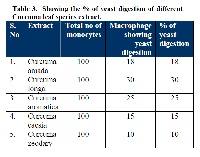Curcuma longa leaves exhibits a potential antioxidant, antibacterial and immunomodulating properties
Keywords:
Curcuma Longa, Curcuma Amada, Curcuma Aromatica, Immounomodulation, CurcuminAbstract
The use of herbs to treat illness has its roots in an ancient holistic healing tradition that originated in Asia more than 3000 years ago. Plants rich in a wide variety of secondary metabolites like tannins, terpanoids, alkaloids, alkaloids and flavonoids, which have been found in vitro to have antimicrobial and antioxidant properties.Turmeric, a representative of plant genus Curcuma, is the member of ginger family, Zingiberaceae. There are five different varieties we have taken Curcuma amada, Curcuma aromatica, Curcuma longa, Curcuma zeodaria, Curcuma caesia. The active substance of turmeric is the polyphenol curcumin, also known as natural yellow 3. It exists at atleast 2 tautomeric forms, keto and enol. It has aroma and flavour and it is used in cosmetics and food additive besides medicinal properties. The present study is a new attempt in leaves segments of the plant Curcuma longa to prove the medicinal potential of the whole plant. This study also includes the comparison of the different species of Curcuma. The active constituents of turmeric are the flavonoid curcumin and volatile oils including turmeron, atlanton and gingibaron. Our experiments are based on 50% methanolic extract of Curcuma leaves to perform anti bacterial, anti oxidant and immunomodulating properties. The antibacterial activity has been done by the help of Disc Diffusion Susceptibility Testing (Kirby-Bauer Method) against four species of bacteria which include Bacillus cereus, Diploccocus pneumoneae, Streptococcus pyrogens & Micrococcus glutamicus. Antioxidant activity has been detected by the Fenton’s reaction. Immunomodulation activity has been seen in curcuma leaves. The results of the present study reveal that all the five species of curcuma exhibit an antioxidant activity and antibacterial activity on different concentration of leave extract. The extract was found to increase the phagocytic activity of macrophages against yeast cells. However, the best activity has been revealed by curcuma longa among the all species of curcuma. In near future the pharmaceuticals studies can be extended to prove its tremendous medicinal properties in case of drug preparation for immune cell properties enhancement and to prove its potential value unlike Curcuma rhizome.
References
Kokate CK, Purohit AP and Gokhale SB.
Pharmacognocy, 12th Ed. Nirali
Prakashan Publishers 1999.
Lewis WH, Elvin-Lewis MP. Medicinal
plants as sources of new therapeutics.Ann
Mo Bot Gard. 1995;82:16-12.
Borris RP. Natural Products research:
perspectives from a major pharmaceutical
company J. Ethnopharmaco. 1996;51:29-
Georges M, Pandelai KM. Investigations
on plant antibiotics.IV. Further search for
antibiotic substances in Indian J Med Res.
;37:169-181.
Rojas A, Hernandez L Pereda-Miranda R,
Mata R. Screening for antimicrobial
activity of crud drug extracts and pure
natural products from Maxican medicinal
plants. J Ethnopharmacol. 1992;35:275-
Silva O, DuarteA, Cabrita J, Pimentael M,
Diniz A, Gomes E. Antimicrobial activity
of Guinea-Bissau traditional remedies. J
Ethnopharmacol. 1996:50:55-59.
Vanden Barghe DA, Vlietinck AJ, Van
Hoof L. Plant products as potential
antiviral agents. Bull inst Pasteur.
:84:101-147.
Geissman TA. Flavanoid compounds,
tannins, lignins, and releted compounds.
In :Florkin M, Stotz EH. , editors. Pyrrole
pigments, isoprenoid compounds and
phenolic plant constituents . Vol. 9. New
York, N .Y: Elsevier; 1963 ;p.265.
Mattill HA “Antioxidants”. Annu Rev
Biochem. 1947;16:177-192.
Wolf G. “The discovery of antioxidant
function of vitamin E: the contribution of
Henry A. Mattill.” J Nutr
;135(3):363-6. PMID 15735064.
Barry Halliwell, Free Radicals and Other
Reactive Species in Disease, Encyclopedia
of Life Sciences 2005.
Toda S, Miyase T, Arich H, et al. Natural
Antioxidants. Antioxidantstive compounds
isolated from rhizonme of Curcuma longa
L. Chem pharmacol Bull. 1985;33:1725-
Alper J. Effort to combat microbial
resistance lags. ASM News. 1998;64:440-
Amoros M, Simoes CMO, Girre L.
Synergistic effect of flavones and
flavanols against herpes simplex virus type
in cell kculture. Comparision with the
antiviral activity of propolis. J Nat Prod.
;55:1732-1740.
Borchers AT, Sakai S, Henderson GL,
Harkey MR, Keen CL, Stern JS, Terasawa
K and Gershwin ME. Shosaiko-to and
other Kampo (Japanes herbal) medicines:
a review of their immunomodulatory
activities. J. Ethanopharmacol. 2000;73:1-
WWW.Cancer.gov.
Hazel B. Mathews,1 George W Lucier1
and Kenneth D. Fisher.2 dicinal Herbs in
the United States: Research Needs,
National Institute of Environmental Health
Science, Research Triangle Park, North
Carolina, USA; Washington, DC, USA



